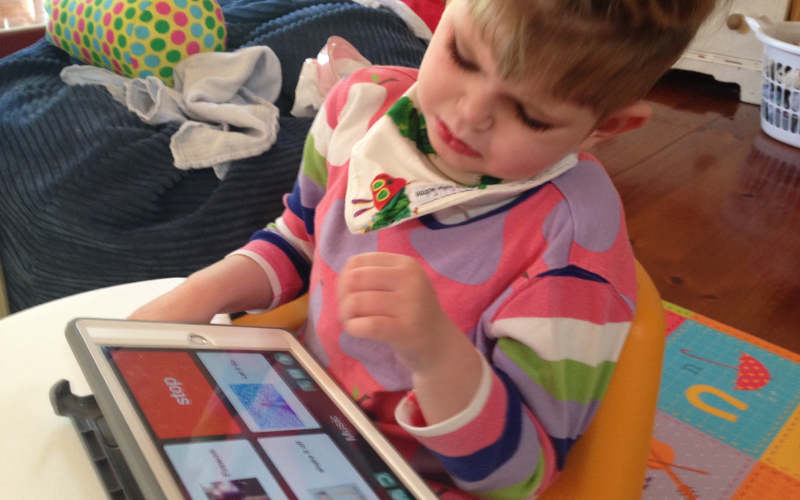Miss Z is non-verbal.
This doesn’t mean she isn’t able to communicate – in fact, she can be surprisingly effective at getting her point across.
As I regularly assure therapists, nurses and doctors, if she doesn’t like something, she will lose no time in letting you know.
Those who spend a lot of time with her can also understand when she’s happy, very happy, bored, in pain or frustrated, mainly through a combination of the tone of her voice and her actions (arm waving and head shaking are happy signs, ear scratching and hair-pulling mean unhappy).
Miss Z also has very limited use of her hands.
She can’t independently isolate one finger from the rest (for example pointing or giving a ‘thumbs up’) and can really only do big, gross motor movements.
For this reason, sign language isn’t very successful for her.
She is able to do a few basic signs and understands several more if she is doing body signing (where we do the sign together), but it is never going to be her easiest or preferred mode of communication.
So, this is where our Communication Revolution begins.
We need to find a system of communication that works for Miss Z.
Augmentative and Alternative Communication (AAC) is the term used to describe various methods of communication that can ‘add-on’ to speech and are used to get around problems with ordinary speech.
AAC includes simple systems such as pictures, gestures and pointing, as well as more complex techniques involving powerful computer technology.
We have started with an iPad and a few basic communication apps.
One of the greatest challenges so far has been finding something that motivates Miss Z enough to actually try to communicate with us through the iPad.
With many children learning augmentative and alternative communication (AAC), food is a great motivator.
Miss Z is completely tube fed, however, so we have settled on some of her favourite activities instead: bouncing, swinging, listening to music, and watching cartoons.
At the moment, her communication choices are limited to which activity she wants to do, and then choosing the song, cartoon, or how long and how fast she swings or bounces, as well as a choice of “finished”.
She can also choose, “yes”, and, “no”, for other types of questions.
We have only just started and for the moment the results are limited.
There are times when she seems to intentionally make choices.
For example, she repeatedly played the Frozen song, “Let it go”, after a nurse commented how much she disliked the song.
However, there are other times where she just isn’t engaged, and even if she does make a choice, I suspect that it was more accident than intention.
With the question of how effective she will be using her hands to make communication choices, we are also planning to have her assessed to see if eye gaze technology might be a better fit for her.
This has been particularly successful for children with limited hand use – such as girls with Rett Syndrome – so it is an exciting prospect.
Whatever communication system we ultimately choose, there isn’t going to be a miracle moment where Miss Z suddenly starts discussing world politics with us, or declares that actually she deeply resents having to wear her sister’s hand-me-down clothes.
Instead, it is going to take a lot of dedication, persistence and work to help her to begin to communicate.
It means giving Miss Z the time she needs to organize herself to communicate – something that can take five minutes or more at the moment.
It means using augmentative and alternative communication all the time in all our interactions – with me modeling it and encouraging Miss Z to respond.
It means forcing her sister to be patient and let her sister make up her own mind.
It means teaching everyone who interacts with Miss Z how she communicates – and making sure they encourage her to use augmentative and alternative communication to respond.
Communication is, without a doubt, the most valuable thing we can give to Miss Z.
If she can communicate, she can gain a measure of control over her life – which will improve her quality of life and her happiness exponentially.
Unlike some revolutions, it isn’t going to happen overnight.
Nor is it going to be easy.
But in the end, it will be worth it.
